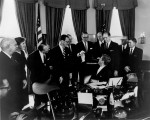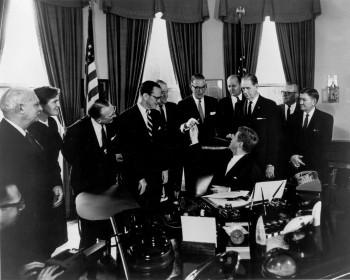
 President Kennedy signs the Drug Efficacy Amendments which are the origin of the "orphan drugs" and in the longer term, the category of "rare diseases", U.S. government works.The category of “rare diseases” was born of the interactions between authorities, patients and the pharmaceutical industry following a consolidation of US pharmaceutical legislation.
President Kennedy signs the Drug Efficacy Amendments which are the origin of the "orphan drugs" and in the longer term, the category of "rare diseases", U.S. government works.The category of “rare diseases” was born of the interactions between authorities, patients and the pharmaceutical industry following a consolidation of US pharmaceutical legislation.
The formula “rare diseases”, referring to the full range of infrequent diseases, appeared in the United States in the mid 70s. It was given a precise description in 1984 in the Orphan Drug Act . This law defines as rare all unprofitable diseases or those affecting less than 200,000 people in the United States (cystic fibrosis, fragile X syndrome, Locked-in syndrome for instance) and provides for the medicines with indication for one of these illnesses the status of “orphan drug”. The pairing of these two notions emerged from an ongoing and circuitous process. In order to understand the history of rare diseases, it is necessary to understand that of orphan drugs as well.
In 1962 in the United States, the 1938 Food, Drug and Cosmetic Act was bolstered with the Kefauver-Harris amendments which required drug manufacturers to provide proof of the effectiveness and safety of their drugs before approval, the new stipulation to be implemented retroactively. No medicine put up for sale after 1938 would be allowed on the market unless its manufacturers could prove its efficiency. Medicines deemed ineffective, noxious or untested were to be withdrawn. The plan did not take into account the implementation of the amendments on the ground, creating problematic situations. Here, some patients had to go without their treatment because their prescription drug, which they considered effective, had not been tested and was not approved in the United States; such patients made their protestations arguing the respect of their consumers rights. There some untested drugs lingered on the shelves of hospital pharmacies which may not be dispensed to the patients. Those medicines became known as “homeless” or “orphan”.
In 1968 the American Society of Hospital Pharmacists called on the Food and Drug Administration to arrive at a resolution of the matter; but it took until the 1980s for the associative and legislative breakthroughs to be achieved. The conferences brought together patients and pharmaceutical representatives under the aegis of the Food and Drug Administration. These encounters helped patient representatives grow aware of the shared characteristics of their experiences, rooted in the rarity of their conditions. They decided to associate on this basis and formed the first coalition of patients associations representing rare disease sufferers, the National Organization for Rare Disorders (NORD). In 1983, a law was passed addressing the problem of orphan drugs, the Orphan Drug Act, which defines them as unprofitable in that they treat infrequent diseases; but the act soon ran into difficulties as the manufacturers seeking this status for their product must provide evidence of their unprofitability. Now most of them had no wish to divulge such data. In 1984 the definition of orphan drugs was refined, setting at 200,000 American citizens the number of patients needed for a drug to qualify, resulting in the conversion of consumer mobilisation into patient mobilisation.
In the mid 90s, France’s pharmaceutical industry saw in the orphan drug status a device towards supporting innovation and asked the powers that be to study the possibility to introduce it into French law, the text in turn broadened the issue to orphan diseases defined as conditions for which few treatments are available. It proposed to provide for processes helping to improve the situation of rare disease sufferers. This gave rise to an associative coalition modelled on NORD, Eurodis (European Organization for Rare Disorders), and the adoption of a European regulation on orphan drugs in 1999. People power along with the creation of diverse extra outfits (reference centres, observatories, directory) have got rare diseases firmly signposted on the French, then European Maps.
Read more in the dictionary : Drapetomania
Read the paper in french :Rares (maladies)
Références :
Philip J. Hilts, Protecting America’s Health. The FDA, Business and 100 Years of Regulation, New York City, Alfred A. Knopf, 2003.
Caroline Huyard, Rare. Sur la cause politique des maladies peu fréquentes, Paris, Éditions de l'École des Hautes Études en Sciences Sociales, 2002.
To quote this paper : Caroline HUYARD, "Rare diseases" in Hervé Guillemain (ed.), DicoPolHiS, Le Mans Université, 2021.